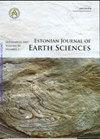芬兰Åland群岛Lumparn湾奥陶系沉积演替时代
IF 0.8
4区 地球科学
Q4 GEOSCIENCES, MULTIDISCIPLINARY
引用次数: 0
摘要
Åland群岛上的古Lumparn陨石撞击构造凹陷部分被下古生代沉积物填满,目前位于海平面以下。寒武系和奥陶系沉积盖层分布面积为15 km2,总厚度达70 m。这个地点的奥陶系碳酸盐岩,通过不稳定的巨石和20世纪50年代末的钻探项目而为人所知,特别有趣的是,这个离群的位置与巴尔托斯坎德古盆地保存的奥陶系沉积物的其他分布区域隔得很远。东巴湾奥陶系剖面由两个不同的岩性单元组成。较老的泥质微晶灰岩单元传统上被命名为“正角砾岩”或“正角砾岩”,较年轻的泥晶灰岩单元被命名为“Östersjö石灰岩”(或“波罗的海石灰岩”)。本文报道了在东巴湾特兰维克地区三个老岩心的介形类生物地层学和稳定碳同位素化学地层学的新资料。爱沙尼亚介形类分布及其演替的比较,总体上支持了前人对正角砾岩的Darriwilian和Sandbian时代的解释。结合介形虫的分布、早期尖形石和牙形石的年代测定、稳定的碳同位素数据和石灰岩岩性,认为正角岩单元可能对应于Kunda、Aseri、Lasnamägi、Uhaku、Kukruse、Haljala和Keila区域阶段(RSs)。Österjö石灰岩几乎包括整个Katian,对应于巴尔托斯坎迪亚地层图中的Rakvere, Nabala, Vormsi和Pirgu RSs。最上面的样本产生了最丰富和最多样化的介形类组合,表明它对应于Vormsi或中下Pirgu (Katian晚期)RSs。在研究的演替中记录了全球中达里威廉碳同位素偏移(mice)和古腾堡碳同位素偏移(GICE)以及Katian Rakvere和Saunja碳同位素偏移。正长角灰岩δ 13c碳水化合物体岩曲线在层段下部呈正偏移1‰,在层段中部呈负偏移1‰,在层段上部呈正偏移2‰。该曲线与爱沙尼亚西北部Hiiumaa岛核心段Darriwilian和Sandbian的碳同位素曲线非常相似,可以解释为mice和GICE的上升翼。Östersjö灰岩段δ 13c曲线有两次正偏移。较低的一个很可能包括爱沙尼亚Rakvere偏移(Rakvere RS)的峰值,这也得到介形虫数据的支持。上面的碳同位素偏移可能代表了与Nabala RS上部相关的Saunja偏移。以正角岩和Östersjö石灰岩单元为特征的介形类生物相,以及这些单元的岩性演替表明,与巴尔托斯坎迪亚古盆地的爱沙尼亚陆架相(北爱沙尼亚陆架相)相比,它们更相似。本文章由计算机程序翻译,如有差异,请以英文原文为准。
Age of the Ordovician sedimentary succession in Lumparn Bay, Åland Islands, Finland
Depression of the ancient Lumparn meteorite impact structure in the Åland Islands is partly infilled with the lower Palaeozoic sediments, lying presently below sea level. The Cambrian and Ordovician sedimentary cover is distributed in the area of 15 km 2 , with a total thickness of up to 70 m. The Ordovician carbonate rocks of this site, known by the erratic boulders and by the drill ing project in the late 1950s, are particularly interesting because of the isolated distant position of this outlier from other distribution areas of the Ordovician sediments preserved in the Baltoscandian Palaeobasin. Ordovician sections in the Lumparn Bay are com posed of two distinct lithological units. The older, argillaceous wackestone-packstone unit has been tradi - tionally named ‘Orthoceras limestone‘ or ‘Orthoceratite Limestone’, and the younger micritic limestone unit is addressed as ‘Östersjö Limestone’ (or ‘Baltic Limestone’). Here we present new data on ostracod biostratigraphy and stable carbon isotope chemo - stratigraphy derived from three old drillcores from the Tranvik area of the Lumparn Bay. The comparison of ostracod distribution with its succession in Estonia generally supports the previous Darriwilian and Sandbian age interpretations for the Orthoceras Limestone. Considering the ostracod distribution together with earlier acritarch and conodont datings, stable carbon isotopic data and limestone lithology, the Orthoceras Limestone unit might correspond to the Kunda, Aseri, Lasnamägi, Uhaku, Kukruse, Haljala, and Keila regional stages (RSs). The Österjö Limestone comprises almost the entire Katian, corresponding to the Rakvere, Nabala, Vormsi and Pirgu RSs in the Baltoscandian stratigraphic chart. The uppermost sample yielded the most abundant and diverse assemblage of ostracods that suggests it to correspond to the Vormsi or lower-middle Pirgu (late Katian) RSs. The global Middle Darriwilian Carbon Isotopic Excursion ( MDICE ) and Guttenberg Carbon Isotopic Excursion ( GICE ) as well as the Katian Rakvere and Saunja carbon isotopic excursions are recorded in the studied succession. The δ 13 C carb bulk rock curve of the Orthoceras Limestone shows a positive excursion up to 1‰ in the lower part of the interval followed by a negative excursion up to –1‰ in the middle part and another positive excursion reaching 2‰ in the upper part of the interval. This curve resembles well the carbon isotope curve from the Darriwilian and Sandbian in the core sections of the Hiiumaa Island, NW Estonia, and could be interpreted as the MDICE and the rising limb of the GICE. The δ 13 C curve of the Östersjö Limestone interval shows two positive excursions. The lower one comprises most likely the peak of the Rakvere Excursion ( Rakvere RS ) in Estonia, which is also supported by the ostracod data. The upper carbon isotopic excursion may represent the Saunja Excursion correlated with the upper part of the Nabala RS. The ostracod biofacies characterized by faunal associations of both the Orthoceras and Östersjö limestone units, and the lithological succession of these units suggest more similarities with the Estonian Shelf facies ( North Estonian Confacies) than Scandinavian Basin facies of the Baltoscandian Palaeobasin.
求助全文
通过发布文献求助,成功后即可免费获取论文全文。
去求助
来源期刊

Estonian Journal of Earth Sciences
地学-地球科学综合
CiteScore
1.50
自引率
9.10%
发文量
11
审稿时长
>12 weeks
期刊介绍:
The Estonian Journal of Earth Sciences is an international scientific open access journal published by the Estonian Academy of Sciences in collaboration with the Tallinn University of Technology, the University of Tartu, the Estonian University of Life Sciences and the Talllinn University.
The journal publishes primary research and review papers in the English language. All articles are provided with short Estonian summaries.
All papers to be published in the journal are peer reviewed internationally.
The journal is open for publications in all fields of Earth sciences, including besides different geological sensu lato disciplines, also geography and oceanography having certain connection with our part of the world, North Europe and the Baltic area in particular.
 求助内容:
求助内容: 应助结果提醒方式:
应助结果提醒方式:


